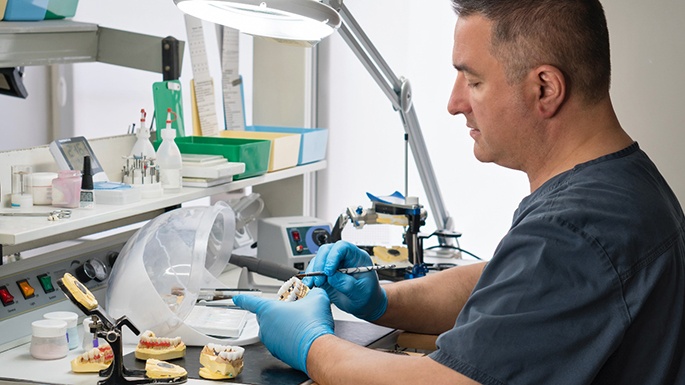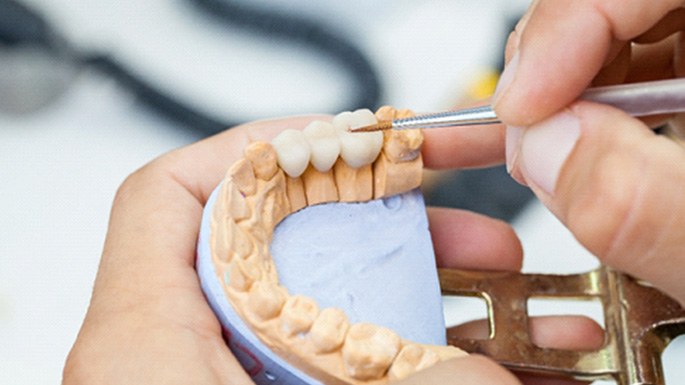Dental Bridges – Philadelphia, PA
Erase the Gap in Your Smile
If you’re missing one or more consecutive teeth, our team at Dentex Dental of Philadelphia can help bridge the gap in your arch and make basic daily tasks like eating and speaking much easier. We use high-quality dental materials, like porcelain and ceramic, to custom-craft your bridges to look virtually indistinguishable from your natural teeth. Plus, replacing your teeth with this time-tested dental treatment can help not only boost your confidence, but also your oral health. To learn whether you’re a good candidate for dental bridges in Philadelphia, call our office today to schedule a consultation.
Why Choose Dentex Dental of Philadelphia for Dental Bridges?
- Conveniently Open Evenings & Saturdays
- High-Quality, Natural-Looking Dental Materials
- Experienced Team of Dentists
What is a Dental Bridge?

A dental bridge is a restoration designed to replace anywhere from one to four missing teeth alongside each other. They’re comprised of two major components: dental crowns and free-standing replacement teeth, called pontics. The crowns are fused to either side of the pontics and act as anchors to hold the replacement teeth within the mouth. They’re fused to the two existing teeth on either side of the gap. Once cemented in place, a dental bridge can last for up to 15 years with good oral hygiene and maintenance.
Types of Dental Bridges

Depending on your unique situation, our dentists in Philadelphia may recommend one of the two different types of dental bridges listed below.
Traditional Dental Bridge
A traditional bridge works as described above—it’s anchored to the existing teeth to keep it from slipping or shifting within the mouth. This will help maintain your dental alignment and make eating and speaking much easier.
Implant Bridge
Implant bridges are able to replace two or more missing teeth, as they’re anchored to dental implants instead of your natural teeth. This minimizes the alteration of your healthy teeth necessary to have a successful treatment. Also, because the implants are surgically placed within the jawbone, allowing them to fuse with the bone, they’re able to prevent it from eroding over time due to lack of stimulation and blood flow.
The Benefits of Getting a Dental Bridge

Making the decision to replace your teeth with a dental bridge will provide you with a variety of benefits and advantages, including:
- Keep your existing teeth from shifting out of place to fill in the gap in your arch.
- Make brushing and flossing more effective and easier.
- Minimize your risk of developing bite problems, cavities, gum disease, and TMJ disorder due to missing teeth.
- Improve your eating and speaking abilities.
- Smile with a greater sense of confidence.
Dental Bridges FAQs

Can You Take a Dental Bridge Out?
Ultimately, no – you can’t take a dental bridge out. This appliance is meant to stay in your mouth for many years. After that period, only a dental professional can perform the removal.
Remember, a dental bridge is fused to your mouth. It’s either cemented to nearby teeth or held in place with dental implants. Either way, trying to take it out yourself will damage your smile. Such harm would defeat the bridge’s entire purpose.
True, some people call partial dentures “removable bridges.” That’s only natural – dentures and bridges have similarities. However, this title for partials just isn’t accurate. A partial denture can be removed as needed, while bridges can’t.
Are Dental Bridges Safe?
When placed by a qualified dentist, a dental bridge is quite safe. It shouldn’t harm any major part of your mouth. On the contrary, it’ll improve your oral health for years!
For starters, bridge materials aren’t toxic. Their crowns only use ceramic and zirconia – metal-free substances without mercury. Plus, the implants in an implant bridge only use titanium. This metal is safe for your mouth and even biocompatible.
Similarly, placing a bridge is also harmless. The process won’t damage your gum tissue in any way. A regular bridge will remove bits of enamel, but that effect is negligible. The crowns placed over the prepped teeth will compensate.
What Can You Not Eat with a Dental Bridge?
Normally, dental bridges should let you chew most foods. That said, there are certain items you should exercise caution around. Doing so will ensure your bridge lasts a long while.
For example, take sticky foods. Such things could loosen your bridge or pull it off your teeth. Therefore, try to avoid fruit gummies, caramel, and sticky candies.
You should go easy on sweet stuff as well. After all, too much sugar may decay the teeth holding your bridge. The restoration could then get loose! So, only eat these treats in moderation.
Do Dental Bridges Look Natural?
Luckily, dental bridges do look natural. Their features let them blend seamlessly with your other teeth. That way, they won’t stand out from the rest of your smile.
Firstly, note the materials in a bridge’s teeth. Ceramic and porcelain have very toothlike looks. So, a given bridge can be color-matched to your other teeth. It’ll then seem like a natural part of your grin.
Of course, don’t forget that bridges won’t fall from your mouth. They’re firmly held in place with crowns or dental implants. As such, they won’t draw attention by (say) slipping around.


 (215) 677-2401
(215) 677-2401